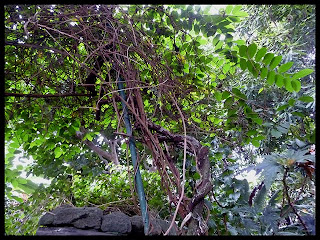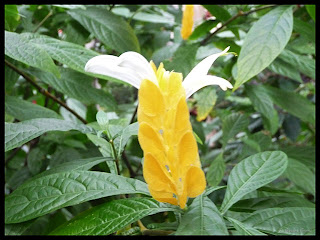Neighbours talking over the garden gate has long been a tradition. They share gardening tips, complain about the weather and pests yet are ever eager to discuss their gardens. That is what I had in mind when creating this blog. So stop by my garden gate to find out the latest happenings in my garden.
Happy Gardening!
Garden Gnome
"All my life through, the new sights of Nature made me rejoice like a child." ~ Madame Marie Curie"
 Tundra SwanFebruary 22, 2010
Tundra SwanFebruary 22, 2010We have had such a mild, precipitation winter this year that I have been extremely concerned as to what this will mean to our local farmers and home gardeners. Despite getting little more than a light flurry with no accumulation between November 2009 and January 2010, February gave a bit of home with now the second of two snow storms consisting of good accumulation. This is a good thing as we need the snow for spring runoff and proper moisture content for spring planting. I'm quite happy with this turn of events!
Happy Gardening!
Garden Gnome©2006-2010
Change is part of every gardener's life. At the moment many of us are dealing with changing climate issues that are changing the way we garden. This year may prove to be more change for us than we originally planned. If all goes according to plan I will be setting up 2 home gardens in 2 very different growing zones. I don't want to say a lot until I am sure but rest assure I will be posting on this as details unravel. This has all come to light as of last Friday so it is even hard for me to fanthom but when the dust is settled and providing things go according to plan you are seriously going to be amazed at this gardening turn of events. Stay tuned and I will be adding updates as so as I get them. In the meantime I am starting seeds indoors so will post more on that as well.
Happy Gardening!
Garden Gnome
©2006-2010
This is the last post on our visit to the
Mitchell Park Conservatory (The Domes) in Milwaukee, Wisconsin. I hope you have enjoyed walking through the domes with us. If you have the opportunity to visit this wonderful conservatory I hope enjoy it as much as we did. There are so many amazing plants to see and don't forget to look up. The domes themselves are quite impressive lending themselves for interesting photo opportunities.
Happy Gardening!
Garden Gnome©2006-2010
 Corpse Flower(Amorphophallus titanum)January 23, 2010
Corpse Flower(Amorphophallus titanum)January 23, 2010The Corpse Flower (
Amorphophallus titanum) gets it name from the distinctive odor of the inflorescence that resembles rotting flesh. It has an unbranched inflorescence that can reach over 3 metres in diameter. The inflrescence contains a male and female flower. The female flower opens first followed a couple of days later by the male flower to prevent self pollination. The fragrant spalix of flowers are wrapped by a splathe that resembles a single flower petal. The corpse flower is native to the equatorial forests of Sumatra, Indonesia.
We visited the
Mitchell Park Conservatory (The Dome) missing the corpse flower in bloom by only a few days. I was quite disappointed as how many chances to you get to see such an amazing plant in bloom?
Happy Gardening!
Garden Gnome©2006-2010
If you have been following this blog you will know that I have highlighting our visit to the Mitchell Park Conservatory (The Domes) in Milwaukee, Wisconsin. The last dome we visited was the tropical dome. Unlike the show and desert domes, the tropical dome was blissfully warm and humid. It was wonderful walking through enjoying the sights and sounds. Many tropical plants make wonderful houseplants where the growing conditions can be controled. I'm always drawn to the plants that I can't easily grow at home indoors or outdoors.
 Zebra Plant
Zebra Plant
The Zebra Plant (Aphelandra squarrosa) is a woody shrub native to Brazil. It is named for the white veins on the dark waxy green leaves. The zebra plant became a houseplant during the Victorian era when growing tropical plants indoors became popular. When used as a flowering houseplant it grows well in moderate to bright filtered light. It does best with higher humidity so either mist regularly or place on a rock humidity tray. The plant has a lovely yellow spike when in bloom as pictured but it can sometimes be difficult to get to bloom as a houseplant. The flower will last for several weeks.
 Grapefruit
Grapefruit
I love citrus trees! At one time years ago I had a small ornamental citrus tree as a houseplant. We've visited Florida several times. The citrus groves are amazing to see but even better but seeing citrus trees growing in backyards is just pure envy. I would have a field day!
I really liked that the conservatory had several temporary signs to draw attention to various plants in bloom or setting fruit so you wouldn't miss them. Looking up the grapefruit tree sure enough there were several nice sized but green grapefruits. Aren't they gorgeous?
 Neem
Neem
The Neem Tree (Azadirachta indica) is a fast growing evergreen native to India. It certainly earns its reputation for being nature's drugstore. Products of neem tree are widely used in traditional Indian medicine (Ayurvedic)and have proven medicinal properties including being anthelmintic, antifungal, antidiabetic, antibacterial, antiviral, anti-fertility, and sedative. Neem oil is pressed from the fruit and stems of the Neem Tree. It is used for cosmetics and skin care as well as being an effective mosquito repellent. Neem gum is used as a bulking agent and for diabetic foods.
 Carob Tree
Carob Tree
The Carob Tree (Ceratonia siliqua) is native to the Mediterranean that grows well in dry climates. The bright, shinny unripened green seedpods are about 5-7 inches in length resembling green beans. They darken to almost pure black becoming somewhat withered when ripe. The edible seeds inside the pod can be eaten as is or ground to use as a chocolate substitute, flour, molasses and alcohol. The seed yield a tragacanth-like gum (manogalactan), called Tragasol an important commercial stabilizer and thickener used in may food products including baked goods, ice cream, salad dressings, sauces, cheese, salami, bologna, canned meats and fish, jelly, and mustard. Once the gum is extracted the seed residue is made into a starch- and sugar-free flour of 60% protein content for diabetics.
Happy Gardening!
Garden Gnome
©2006-2010

 Desert Dome PondJanuary 23,2010
Desert Dome PondJanuary 23,2010When it comes to deserts a lot of people don't think of ponds being part of the natural landscape however they are. The desert dome at the
Mitchell Park Conservatory (The Domes) had a lovely, peaceful small pond in the centre of the landscape. I could just imagine thirsty wildlife stopping briefly on their journey for a bit of refreshment.
Happy Gardening!
Garden Gnome©2006-2010
As promised the desert dome in the Mitchell Park Conservatory (The Domes) in Milwaukee, Wisconsin conversation continues. Despite the temperature in the dome being close to the cold outdoor temperatures we spent a fair amount of time in the desert dome. There is just something about arid plants that appeal to me perhaps because they are just so exotic.
 Graham's Sage
Graham's Sage
Graham's Sage (Salvia microphylla [in US Salvia grahamii]) is a low growing perennial, evergreen shrub indiginous to southeastern Arizona and the mountains of eastern, western, and southern Mexico. It is a member of the dead-nettle Lamiaceae family sometimes referred to as blackcurrent sage. There are numerous hybrids and cultivars since the 1990s because the plant easily hybridizes. It is favourved for conservatory cultivation due to its long flowering season of up to 9 months outside and all year indoors. The flowers are arranged in whorls, with a wide range of color (magenta, red, pink, rose) depending on the cultivar. Unfortunately the Graham's Sage was not in bloom during our visit.
 Palms
Palms
I fell in love with palm trees our first visit to Las Vegas that lined the streets and graced most landscaping. That love was reinforced through a few trips to Florida but my gosh where I really started to appreciate them was in Key West. The palms waved in the wind making a rustling sound while providing cooling shade in the heat of the sun. In the evening hours the shadows created by the palms were amazing then at night listening to the rustling in the deep darkness it was easy to believe the local ghost stories. Perhaps the local ghosts were actually visiting us!
Happy Gardening!
Garden Gnome
©2006-2010

Yesterday I posted on a bit on the desert dome at the Mitchell Park Conservatory (The Domes) in Milwaukee, Wisconsin. I took a fair number of pictures so will be sharing some of those with you over the next couple of days. Cacti can be grown successfully indoors in northern climates in a sunny window. It is amazing to see the variety of cacti available, some more suitable to growing indoors for the gardener than others.
 Cleistocactus
Cleistocactus
A nice feature of conservatories is many of the plants are labeled with their common and scientific names. If this is a plant you are interested in trying your hand at growing then take a picture along with recording the tag information. This will help ensure you get exactly the plant you are looking for.
Cleisrocactus (Cleistocatus hyalacanthus) [note a typo on the card] is a columnar cactus that is hardy to USDA Zones 10 and 11. This tall, fuzzy cactus grows to 4 - feet in height with small pink or pale red diurnal flowers about 1.6 - inches long.
 Welwitschia
Welwitschia
Welwitschia (front bottom) is a low sprawling, sideways growing plant that grows from a short, thick, woody trunk. Two leaves continuously grow from their base for the entire lifespan (1,000 years or more) of the plant. These leaves split to form several strap-shaped sections disguising their origin. Welwitchia has a long, thick taproot.
Variegated Elephants Bush (Portulacaria afra variegata), just behind the Welwitschia is a small branching succulent shrub. It resembles a small variegated jade plant. This plant can make a fabulous indoor or outdoor container plant. If growing outdoor it is hardy to USDA Hardiness Zone 10. Indoors treat as would other succulents such as jade. Be careful to not overwater. Variegated Elephants Bush has tiny pink blooms but these are seldom seen under cultivation.
Happy Gardening!
Garden Gnome
©2006-2010

Living in Ontario, Canada I don't have a lot of experience with cacti other than the few I grow on my windowsill. My little cacti seedlings are coming along nicely and while they are about double in size they sure take a long time to grow! I can fully appreciate how long it takes for a cactus to get to any appreciable size. Mine are now 3 years old and aren't even big enough to transplant. I'll have to remember to post an update :)
Most think of the desert as a hot, dry area and it it but it is surprising how very cold the desert can get! We've been in the Mojave Desert several times. While the temperatures can be stifling hot as high as 134ºF in Death Valley during the day the low can be as low as 8ºF at night. The Desert Dome of the Mitchell Park Conservatory (The Domes) was really on the cold side not much warmer if any than outdoors when we went through. Coats were a must!
 Aloe Vera
Aloe Vera
I took a lot of pictures in the desert dome. Despite the cold it was quite enjoyable. Understated yet rustic accents like a cattle sculls were scattered randomly throughout the dome. Once again the dome was set up with plants bordering the perimeter of the dome with a well planted central region containing a small pond and a meandering path with benches to sit and enjoy.
I immediately recognized the aloe vera plant in the lower left corner. Aloe vera is a must have plant in any home. It is low maintenance with healing benefits especially for kitchen cuts and burns. I love the natural looking landscape showing this wonderful plant in its natural environment.
 Golden Barrel Cactus
Golden Barrel Cactus
The Golden Barrel Cactus (Echinocactus grusonii) is a Mexican native that is a protected species even though it is a popular cultivated species especially for houseplants but also in landscaping in suitable areas. This cactus lives to to be several hundred years old. The spines provide shade yet help catch rainfall directing it to the base of the plant. The accordion like folds expand and contract depending on the amount of rainfall the plant absorbs. One myth is the barrel cactus is a reservoir for fresh water but this is wrong even though moisture can be squeezed from the pulp.
Happy Gardening!
Garden Gnome
©2006-2010





 tropic canopy
tropic canopy
 Orchid
Orchid Banana Tree
Banana Tree Golden Shrimp
Golden Shrimp Zebra Plant
Zebra Plant Grapefruit
Grapefruit Neem
Neem Carob Tree
Carob Tree
 Graham's Sage
Graham's Sage Palms
Palms Cleistocactus
Cleistocactus Welwitschia
Welwitschia Aloe Vera
Aloe Vera Golden Barrel Cactus
Golden Barrel Cactus















